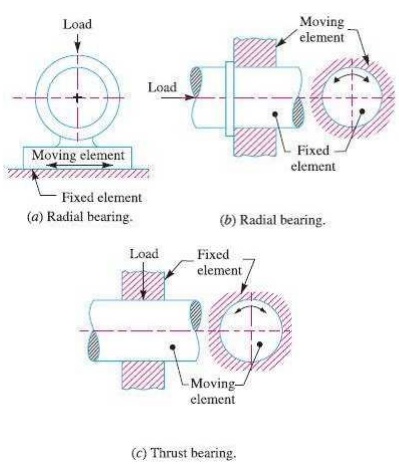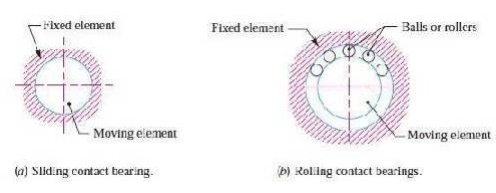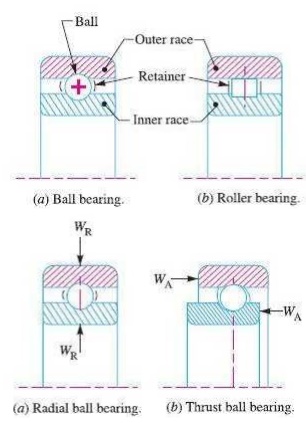Chapter: Mechanical : Design of Machine Elements : Design of Bearings Miscellaneous Elements
Design of Bearings Miscellaneous Elements
DESIGN OF
BEARINGS MISCELLANEOUS ELEMENTS
Sliding
Contact Bearings
A bearing is a machine element which support
another moving machine element (known as journal). It permits a relative motion
between the contact surfaces of the members, while carrying the load. A little
consideration will show that due to the relative motion between the contact
surfaces, a certain amount of power is wasted in overcoming frictional
resistance and if the rubbing surfaces are in direct contact, there will be
rapid wear. In order to reduce frictional resistance and wear and in some cases
to carry away the heat generated, a layer of fluid (known as lubricant) may be
provided. The lubricant used to separate the journal and bearing is usually a
mineral oil refined from petroleum, but vegetable oils, silicon oils, greases
etc., may be used.
1
Classification of Bearings
Though the bearings may be classified in many ways,
yet the following are important from the subject point of View:
1.1
Depending upon the direction of load to be supported.
The
bearings under this group are classified as:
Radial bearings, and
Thrust bearings.
In radial
bearings, the load acts perpendicular to the direction of motion of the moving
element as shown in Fig (a) and (b). In thrust bearings, the load acts along
the axis of rotation as shown in Fig (c).

1.2
Depending upon the nature of contact. The bearings under this group are
classified as:
Sliding contact bearings, and
Rolling contact bearings.
In
sliding contact bearings, as shown in Fig (a), the sliding takes place along
the surfaces of contact between the moving element and the fixed element. The
sliding contact bearings are also known as plain bearings.
In
rolling contact bearings, as shown in Fig (b), the steel balls or rollers, are
interposed between the moving and fixed elements. The balls offer rolling
friction at two points for each ball or roller.

2 Types of
Sliding Contact Bearings
The sliding contact bearings in which the sliding
action is guided in a straight line and carrying radial loads, as shown in Fig
(a), may be called slipper or guide bearings. Such
type of bearings are usually found in cross-head of steam engines. The sliding
contact bearings in which the sliding action is along the circumference of a
circle or an arc of a circle and carrying radial loads are known as journal or sleeve
bearings. When the angle of contact of the bearing with the journal is 360° as
shown in Fig (a), then the bearing is called a full journal bearing. This
type of bearing is commonly used in industrial machinery to accommodate bearing
loads in any radial direction.
When the angle of contact of the bearing with the
journal is 120°, as shown in Fig (b), then the bearing is said to be partial
journal bearing. This type of bearing has less friction than full
journal bearing, but it can be used only where the load is always in one
direction. The most common application of the partial journal bearings is found
in rail road car axles. The full and partial journal bearings may be called as clearance
bearings because the diameter of the journal is less than that of bearing.
When a partial journal bearing has no clearance
i.e. the diameters of the journal and bearing are equal, then the bearing is
called a fitted bearing, as shown in Fig (c). The sliding contact bearings,
according to the thickness of layer of the lubricant between the bearing and
the journal, may also be classified as follows:
Thick film bearings. The thick
film bearings are those in which the working surfaces are completely
separated from each other by the lubricant. Such type of bearings are also
called as hydrodynamic lubricated bearings.
Thin film bearings. The thin
film bearings are those in which, although lubricant is present,
the working surfaces partially contact each other atleast part of the time.
Such type of bearings are also called boundary lubricated bearings.
Zero film bearings. The zero
film bearings are those which operate without any lubricant present.
Hydrostatic
or externally pressurized lubricated bearings. The
hydrostatic bearings are those which can support steady
loads without any relative motion between the journal and the bearing. This is
achieved by forcing externally pressurized lubricant between the members.
Rolling
Contact Bearings
In rolling contact bearings, the contact between
the bearing surfaces is rolling instead of sliding as in sliding contact
bearings. We have already discussed that the ordinary sliding bearing starts
from rest with practically metal-to-metal contact and has a high coefficient of
friction. It is an outstanding advantage of a rolling contact bearing over a
sliding bearing that it has a low starting friction. Due to this low friction
offered by rolling contact bearings, these are called antifriction
bearings.
1
Advantages and Disadvantages of Rolling Contact Bearings over Sliding Contact
Bearings
The following are some advantages and disadvantages
of rolling contact bearings over sliding contact bearings
Advantages
Low
starting and running friction except at very high speeds.
Ability
to withstand momentary shock loads.
Accuracy
of shaft alignment.
Low cost
of maintenance, as no lubrication is required while in service.
Small
overall dimensions.
Reliability
of service.
Easy to
mount and erect.
Cleanliness.
Disadvantages
More
noisy at very high speeds.
Low
resistance to shock loading.
More
initial cost.
Design of
bearing housing complicated.
2 Types of
Rolling Contact Bearings
Following
are the two types of rolling contact bearings:
Ball bearings; and
Roller bearings

The ball and roller bearings consist
of an inner race which is mounted on the shaft or journal and an outer race
which is carried by the housing or casing. In between the inner and outer race,
there are balls or rollers as shown in Fig.
A number of balls or rollers are used and these are
held at proper distances by retainers so that they do not touch each other. The
retainers are thin strips and is usually in two parts which are assembled after
the balls have been properly spaced. The ball bearings are used for light loads
and the roller bearings are used for heavier loads. The rolling contact
bearings, depending upon the load to be carried, are classified as:
Radial bearings, and
Thrust bearings.
The radial and thrust ball bearings are shown in
Fig (a) and (b) respectively. When a ball bearing supports only a radial load
(WR), the plane of rotation of the ball is normal to the centre line of the
bearing, as shown in Fig (a). The action of thrust load (WA) is to shift the
plane of rotation of the balls, as shown in Fig (b). The radial and thrust
loads both may be carried simultaneously.
Related Topics